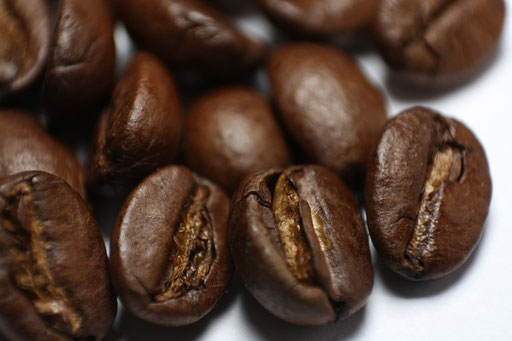Herbs - Medicinal Plants
Coffee. Properties and benefits
Identification and origin of Coffee

Scientific name: Coffea arabica
Coffee is a shrub or small tree of 1-7 meters height. Opposite leaves, bright, mostly oblong, with prominent veins on both sides. Fragrant white flowers in tight clusters located in the leaf axils. Fleshy fruit, globose or oval, red or yellow when ripe which contains 2 olive greenish-brown fruit seeds. The parts used are the seeds.
Its origin is discussed, probably from Ethiopia but is now cultivated in many tropical regions of the world particularly in Brazil, Colombia, Mexico and Ethiopia.
Coffee content and active ingredients
Coffee main active ingredients are the methylated derivatives of xanthines: Caffeine (0.6 - 2.2%) and some amounts of theobromine and theophylline.
Caffeine is present in the whole plant, except the roots and seeds which is about the 13%.
Coffee also contains minerals: potassium, sodium, calcium, magnesium. Organic acids: chlorogenic or caffeoylquinic acid. Contains trigonelline and the leaves methyl salicylate.
When coffee beans are not ripe, contain chlorogenic acid, glycosides and trigonelline which becomes nicotinic amide during the roasting.
Properties and benefits of coffee

Caffeine is a stimulant of the central nervous system at neuromuscular and psychological level. Potassium salts give it a diuretic action, reinforced by chlorogenic acid, responsible for its choleretic and expectorant activity. Increases gastric motility and intestinal peristalsis. In topical application is lipolytic. The decoction of coffee leaves have purifying properties to improve blood circulation and hemorrhagic conjunctivitis.
The infusion of coffee seeds roasted and ground is considered of antiasthmatic properties, anthelmintic, anaphrodisiac, antipyretic, antirheumatic, anti jaundice and to ease childbirth.
The Café is indicated in cases of psychophysical asthenia, hypotension, bradycardia, biliary dyskinesia, constipation, bronchitis, opioid intoxication, cardiorespiratory depression. Localized fat (cellulite).
Uses of Coffee
Warnings
Not associate coffee use with tranquilizers or other stimulants such as ginseng, Eleutherococcus, kola nut, guarana, mate, ephedra, etc.
It can cause insomnia, nervousness, tachycardia, palpitations. By its alkaloid content is advisable to take discontinuously. Coffee is addictive in prolonged use.
Caffeine it´s often included in antimigraine formulations since it’s been proved that increases the effectiveness of the analgesic.
Do not consume coffee if pregnant, hepatitis, heart disease, circulatory disorders, ulcer or gastritis. High doses can cause headache, nausea, insomnia and dependence.
Children are much more sensitive. Generally should not be consumed more than 5 cups of coffee a day.
Preparation and Dosage
Coffee infusion (5-7 g / l): one to two cups a day, after breakfast and lunch.
Topical use: Caffeine or glycolic extract (1:5), by lipolytic gels or creams.
For hemorrhagic conjunctivitis must be prepared a decoction with 15 leaves of coffee, boil for 15 min, cooled and bottled. Wash the eyes 2-3 times a day.


 Pharmacognosy´s topics - Medicinal plants
Pharmacognosy´s topics - Medicinal plants

































Write a comment
damodaranswaminathan (Tuesday, 14 April 2015 17:42)
Highly informative site.